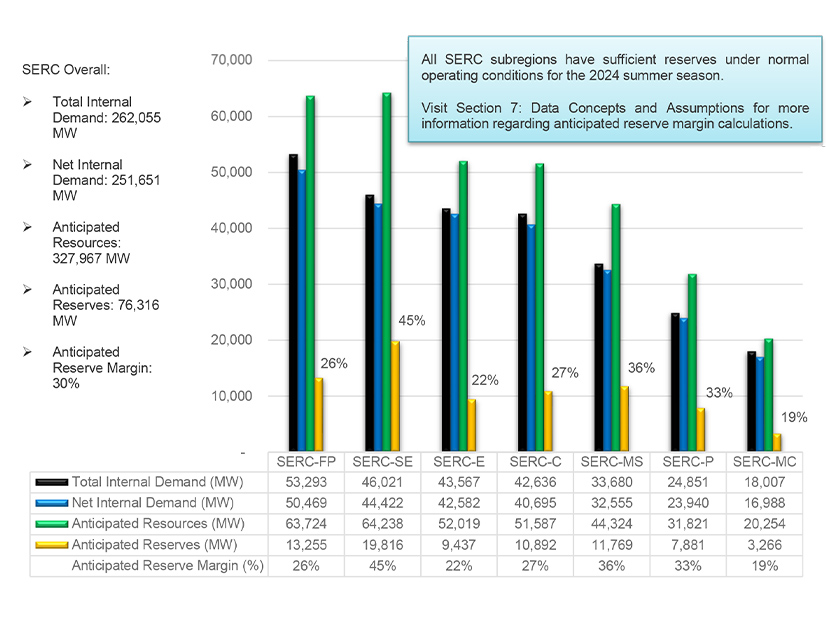The SERC Reliability region is positioned to meet peak demand under normal conditions this summer, although extreme heat and a busy hurricane season could cause concerns for grid operators, the organization said in its 2024 Summer Reliability Assessment released May 30.
SERC produces its summer assessment each year as a complement to NERC’s annual SRA, which the ERO released last month. (See NERC Summer Assessment Sees Some Risk in Extreme Heat Waves.) The report focuses on four key areas relevant to SERC and its subregions — demand, capacity resource adequacy, reserve margins and transmission adequacy — but “does not predict events or weather conditions” during the summer months.
In addition, SERC’s report “focuses on normal summer conditions,” or conditions with a 50% likelihood of coming to pass, while NERC’s assessment also considers an extreme “90/10” scenario (indicating a situation the ERO expects has only a 10% chance of happening). SERC’s assessment does include its summer transmission reliability study, which examines both 50/50 and 90/10 load projections.
In its assessment, the regional entity observed that its “footprint is susceptible to extreme heat, droughts, floods, tornadoes and hurricanes during the summer months.” The region has experienced an average of six heat waves per year over the past decade, compared to two per year in the 1960s. According to the National Oceanic and Atmospheric Administration’s weather forecast for June through August, the 16 states covered by SERC have a 43 to 50% chance of experiencing above-normal temperatures this summer.
NOAA also has predicted an above-normal 2024 Atlantic hurricane season, with 17 to 25 total named storms with winds of at least 39 mph, including up to 13 hurricanes (with winds of at least 74 mph). By comparison, 20 named storms occurred in the 2023 hurricane season, including seven hurricanes. In an average hurricane season, 14 named storms develop, and seven of these become hurricanes. SERC’s report noted the “risk of physical damage and disruption” to power facilities from hurricanes and other extreme weather events.
Along with these risks, the report also highlighted above-normal precipitation predicted across much of SERC’s footprint this summer. The RE warned that heavy rainfall can result in rapid vegetation growth, potentially interfering with transmission lines.
Despite these challenges, SERC emphasized that all its subregions have reported sufficient reserves to meet demand under normal circumstances.
Across the region, total internal peak demand — defined as the projected sum of metered generator outputs and metered line flows into the system, minus metered line flows out of the system — is projected at 262 GW. Total net internal demand — the total internal demand less controllable and dispatchable demand response — is predicted to be 252 GW. By contrast, last year’s actual system peak was 262 GW, against a forecast of 249 GW.
To meet this demand, SERC’s regionwide anticipated resources, including power transfers, stand at 328 GW, with all seven subregions also reporting sufficient internal resources to meet their expected loads. The smallest margin between resources and demand is found in MISO-Central — comprising parts of Illinois, Iowa, Kentucky and Missouri — where 20 GW of resources are available to meet 17 GW of net internal demand.
The region’s generation mix is varied, but SERC expects natural gas to account for just under 50% of generation capacity this summer with 161.4 GW. Coal is next with 64.2 GW at 19.9% of capacity, followed by nuclear energy — including the recently completed third and fourth units at Plant Vogtle in Georgia — at 42.7 GW and 13.2%. (See Southern Credits Strong Southeast Economy for Earnings Growth.)
The RE said fuel availability for gas and coal plants within the region constitutes a potential reliability risk for utilities in the region. SERC also noted severe weather poses a moderate risk of transmission impacts, though it also said its transmission reliability study projected only “localized thermal overloads and no voltage constraints in the SERC region” for both the 50/50 and 90/10 forecasts.



